Field values
If instance data have been collected for the selected instance, the field values are presented in the Field values tree. If instance data have not been collected, a single entry with the message **“(No instance data available)” **will be shown. To define when instance data are collected for an instance, the Instance Data Settings Page should be used.
If the type of the instance has any static fields, the Field values tree will also contain all static fields of the type, grouped by AppDomain (for normal static fields), or by thread (for thread static fields).
If the instance itself is a primitive type (e.g., a boxed int, double, or a string), the value of the instance is presented as a single field with the name (value). Otherwise, the fields of the instance are presented together with their values in the table, using the following columns:
Name
This column shows the name of the field.Value
This column shows the value of the field. How the value is presented is described below.Type
This column shows the type of the field. If the type is a primitive type (e.g. int, long, float, double, object or string**), **the primitive name will be used. Otherwise, the name of the type will be used. If the actual type of the referenced instance differs from the field type, the actual type is also included after the field type.
Presentation Style
Using the Preferences settings, it is possible to select two different styles of presenting the fields, i.e., Visual Studio and Flat.
Visual Studio
The Visual Studio style mimics the way fields are presented in the Visual Studio Variables windows. The fields are presented in a hierarchy based on the type they are declared in, and they are sorted alphabetically.

Flat
The fields are presented in the order they are declared in the Types, without any hierarchy and with the top-level type fields first.

Value Presentation
The way the field value is presented depends on the type of the field:
Primitive numeric type (e.g., byte, short, int, long, float, and double):
The value is converted to its string representation. A suffix is added to floats and doubles (‘f’ and ‘d,’ respectively).
Reference type:
If the reference field is null, then it is presented as “null.” Otherwise, the instance number of the instance it references is presented.
If the referenced instance is a string (System.String), the contents of the string are presented after the instance number.
If the referenced instance is a boxed primitive numeric type, the value of the unboxed instance is presented, within braces, after the instance number.
Otherwise, if the type of the referenced instance differs from the type of the field, the name of the type is presented, within braces, after the instance number. For example, if the field type is System.Collection.ICollection and the referenced instance is of type System.Collection.ArrayList, the value will be presented as: “#xxxx {ArrayList}.”
The ‘+’ can be clicked to investigate the field values of the referenced instance. To view the details of the referenced instance, double-click the reference or select “Show Instance Details.”
Note
Information about the referenced instance (type, string value, or boxed value) can be presented only if instance data have been collected for the referenced instance.
Value type:
A text representation of the fields in the value type is presented in the Value column, within braces. Additional information about the fields in the value type is available by clicking ‘+.’